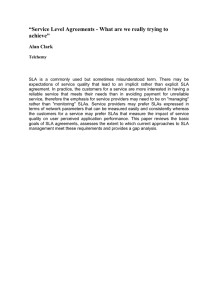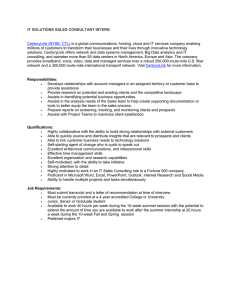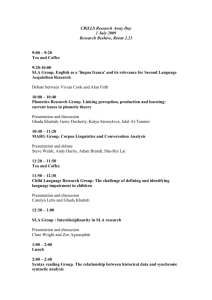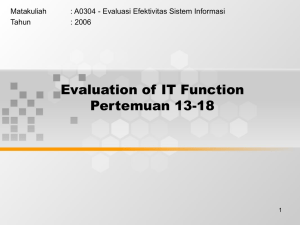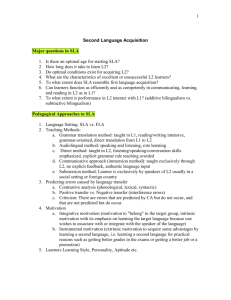Page 1 © CenturyLink, Inc. All Rights Reserved. CONFIDENTIAL v1
advertisement
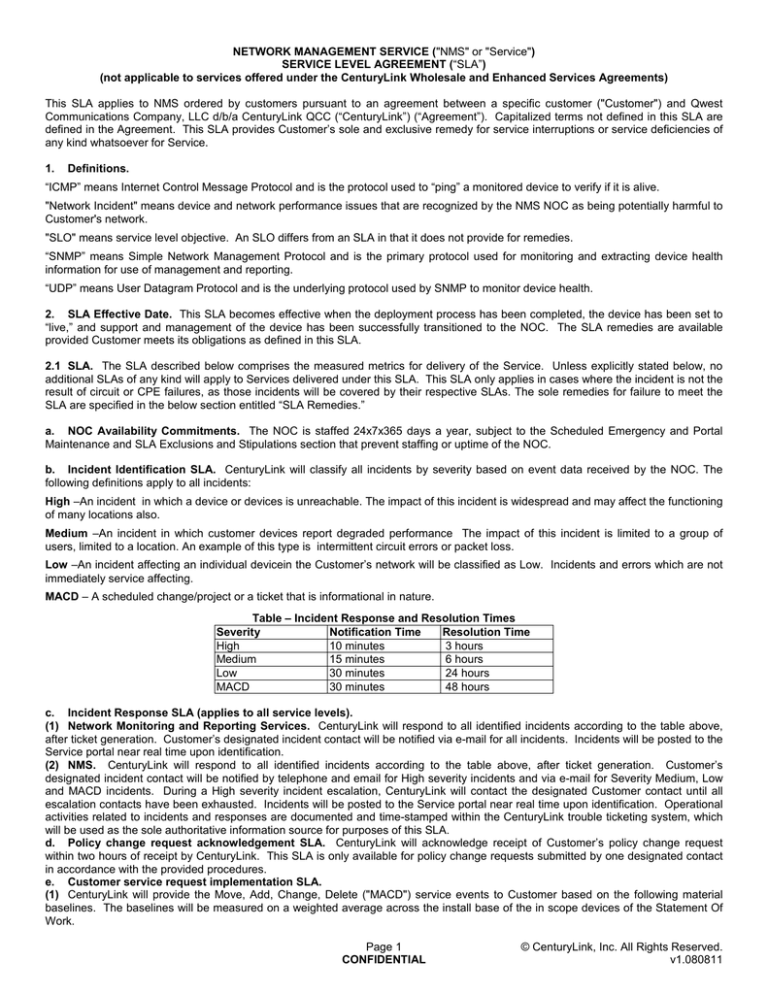
NETWORK MANAGEMENT SERVICE ("NMS" or "Service") SERVICE LEVEL AGREEMENT (“SLA”) (not applicable to services offered under the CenturyLink Wholesale and Enhanced Services Agreements) This SLA applies to NMS ordered by customers pursuant to an agreement between a specific customer ("Customer") and Qwest Communications Company, LLC d/b/a CenturyLink QCC (“CenturyLink”) (“Agreement”). Capitalized terms not defined in this SLA are defined in the Agreement. This SLA provides Customer’s sole and exclusive remedy for service interruptions or service deficiencies of any kind whatsoever for Service. 1. Definitions. “ICMP” means Internet Control Message Protocol and is the protocol used to “ping” a monitored device to verify if it is alive. "Network Incident" means device and network performance issues that are recognized by the NMS NOC as being potentially harmful to Customer's network. "SLO" means service level objective. An SLO differs from an SLA in that it does not provide for remedies. “SNMP” means Simple Network Management Protocol and is the primary protocol used for monitoring and extracting device health information for use of management and reporting. “UDP” means User Datagram Protocol and is the underlying protocol used by SNMP to monitor device health. 2. SLA Effective Date. This SLA becomes effective when the deployment process has been completed, the device has been set to “live,” and support and management of the device has been successfully transitioned to the NOC. The SLA remedies are available provided Customer meets its obligations as defined in this SLA. 2.1 SLA. The SLA described below comprises the measured metrics for delivery of the Service. Unless explicitly stated below, no additional SLAs of any kind will apply to Services delivered under this SLA. This SLA only applies in cases where the incident is not the result of circuit or CPE failures, as those incidents will be covered by their respective SLAs. The sole remedies for failure to meet the SLA are specified in the below section entitled “SLA Remedies.” a. NOC Availability Commitments. The NOC is staffed 24x7x365 days a year, subject to the Scheduled Emergency and Portal Maintenance and SLA Exclusions and Stipulations section that prevent staffing or uptime of the NOC. b. Incident Identification SLA. CenturyLink will classify all incidents by severity based on event data received by the NOC. The following definitions apply to all incidents: High –An incident in which a device or devices is unreachable. The impact of this incident is widespread and may affect the functioning of many locations also. Medium –An incident in which customer devices report degraded performance The impact of this incident is limited to a group of users, limited to a location. An example of this type is intermittent circuit errors or packet loss. Low –An incident affecting an individual devicein the Customer’s network will be classified as Low. Incidents and errors which are not immediately service affecting. MACD – A scheduled change/project or a ticket that is informational in nature. Table – Incident Response and Resolution Times Severity Notification Time Resolution Time High 10 minutes 3 hours Medium 15 minutes 6 hours Low 30 minutes 24 hours MACD 30 minutes 48 hours c. Incident Response SLA (applies to all service levels). (1) Network Monitoring and Reporting Services. CenturyLink will respond to all identified incidents according to the table above, after ticket generation. Customer’s designated incident contact will be notified via e-mail for all incidents. Incidents will be posted to the Service portal near real time upon identification. (2) NMS. CenturyLink will respond to all identified incidents according to the table above, after ticket generation. Customer’s designated incident contact will be notified by telephone and email for High severity incidents and via e-mail for Severity Medium, Low and MACD incidents. During a High severity incident escalation, CenturyLink will contact the designated Customer contact until all escalation contacts have been exhausted. Incidents will be posted to the Service portal near real time upon identification. Operational activities related to incidents and responses are documented and time-stamped within the CenturyLink trouble ticketing system, which will be used as the sole authoritative information source for purposes of this SLA. d. Policy change request acknowledgement SLA. CenturyLink will acknowledge receipt of Customer’s policy change request within two hours of receipt by CenturyLink. This SLA is only available for policy change requests submitted by one designated contact in accordance with the provided procedures. e. Customer service request implementation SLA. (1) CenturyLink will provide the Move, Add, Change, Delete ("MACD") service events to Customer based on the following material baselines. The baselines will be measured on a weighted average across the install base of the in scope devices of the Statement Of Work. Page 1 CONFIDENTIAL © CenturyLink, Inc. All Rights Reserved. v1.080811 (2) The following table lists the maximum number of MACD events per device and target execution time. Note that target criteria for execution time is a target that 95% of all monthly MACD requests will be satisfied in the stated execution time. Table: MACD for Network devices Standard MACD Execution Time Major 2 Business Days Medium 1 Business Day Minor 1 Business Day f. Emergency Change Request Implementation SLA. CenturyLink will implement Customer emergency policy change requests after the issue is categorized by the NMS NOC, complexity is assessed and resolution time is mutually agreed to by Customer and CenturyLink’s NMS NOC engineer. All emergency policy requests will be documented via a change submission through the service portal following notification by telephone. (1) This SLA is only available for policy change requests submitted by a valid customer contact in accordance with established procedures. (2) CenturyLink will promptly notify Customer upon implementation of a change request by telephone, e-mail, pager, or electronic response via the Service portal (3) A ticket will be generated per request and made visible via the service portal. The ticket will contain detail on the request. Table – SLA Summary Service Level Agreements Remedies for NMS Customer (all service levels) NOC Availability Incident identification SLA NMS Customer may obtain no more than one credit Incident response SLA for each SLA per incident per device managed by Policy change request acknowledgement SLA CenturyLink, not to exceed a total of 100% of the equivalent MRC in local currency for a given device, Policy change request implementation SLA in a given calendar month. Customer SLA credits Emergency change request implementation SLA (Premium cannot exceed $25,000 in a calendar month. level only) Proactive system monitoring SLA 2.2 SLA Remedies. a. A credit is calculated as: credit = 2 x daily prorated MRC b. A credit will be issued to customer as the sole remedy for failure to meet any of the SLAs described in the section entitled “SLA,” during any given calendar month. Customer may obtain no more than one credit for each SLA per incident per device managed by CenturyLink, not to exceed a total of 100% of the equivalent MRC in local currency for a given device, in a given calendar month. Customer SLA credits cannot exceed $25,000 in a calendar month. (1) NOC availability, incident identification, incident response, policy change request acknowledgement, policy change request implementation, emergency change request implementation, proactive system monitoring and remedies – If CenturyLink fails to meet any of these SLAs, a credit will be issued for the applicable charges for two days of the monthly monitoring fee for the affected device. Table - SLAs and Remedies Summary Service Level Agreements Remedies for NMS Customer (all service levels) NOC Availability Incident identification SLA NMS Customer may obtain no more than one credit Incident response SLA for each SLA per day per device managed by Policy change request acknowledgement SLA CenturyLink, not to exceed a total of 100% of the equivalent MRC in local currency for a given device, Policy change request implementation SLA in a given calendar month. Customer SLA credits Emergency change request implementation SLA (Premium cannot exceed $25,000 in a calendar month. level only) Proactive system monitoring SLA 2.3 Scheduled and Emergency Portal Maintenance. Scheduled maintenance will mean any maintenance: a. of which Customer is notified at least five days in advance; or b. that is performed during the standard monthly maintenance window on the second Tuesday of every month from 11 pm to 6 am. Central Time. Notice of scheduled maintenance will be provided to the designated Customer contact. No statement in the section entitled “SLA” will prevent CenturyLink from conducting emergency maintenance on an “as needed” basis. During such emergency maintenance, the affected Customer’s primary point of contact will receive notification within 30 minutes of initialization of the emergency maintenance and within 30 minutes of the completion of any emergency maintenance. 2.4 SLA Exclusions and Stipulations. a. Customer Contact Information. Multiple SLAs require CenturyLink to provide notification to the designated Customer contact after certain events occur. In the case of such an event, Customer is solely responsible for providing CenturyLink with accurate and current contact information for the designated contact(s). The current contact information on record is available to authorized contacts through the Service portal. CenturyLink will be relieved of its obligations under this SLA if Customer contact information is out of date or inaccurate due to Customer action or omission. b. Customer Network/Server Change Notifications. Customer is responsible for providing CenturyLink advance notice regarding any network or server changes to the firewall environment. If the event advance notice cannot be provided, Customer is required to Page 2 CONFIDENTIAL © CenturyLink, Inc. All Rights Reserved. v1.080811 provide CenturyLink with notification of changes within seven business days of said network or server changes. Notification is completed by the submission or update of a critical server ticket through the Service portal. If Customer fails to notify CenturyLink as stated above, all SLA remedies directly related to Customers failure to provide such notification are considered null and void. c. Maximum Penalties/Remedies Payable to Customer. The total SLA credits (called “remedies”) provided by NMS for network firewalls – Standard, and Managed UTM Service, described in the sections entitled “SLAs” and “SLA Remedies” above, will not exceed the MRCs for one calendar month. d. Network Traffic Applicable to SLAs. Certain SLAs focus on the prevention, identification, and escalation of security incidents. These SLAs assume that traffic has successfully reached the firewall and therefore the firewall has the ability to process the traffic against the installed policy and generate a logged event. Traffic that does not pass through a firewall, or that does not generate a logged event, is not covered under these SLAs. e. SLA Compliance and Reporting. SLA compliance and the associated remedies are based on fully functional network environments, Internet, and circuit connectivity, firewalls, and properly configured servers. If SLA compliance failure is caused solely by CPE hardware or software (including any and all software agents, all SLA remedies are considered null and void. CenturyLink will provide SLA compliance reporting through the Service portal. f. Testing of Monitoring and Response Capabilities. Customer may test CenturyLink monitoring and response capabilities by staging simulated or actual reconnaissance activity, system or network attacks, and/or system compromises. These activities may be initiated directly by Customer or by a contracted third party with no advance notice to CenturyLink. SLAs will not apply during the period of such staged activities, and remedies will not be payable if the associated SLA(s) are not met. g. Interruptions or Times of Service Degradation. In addition to other exclusions stated in this SLA, the commitments outlined in the UTM SLA section will not apply in the event Service is unavailable or impaired due to any of the following: (1) Negligence, Error, or Customer Caused. Interruptions or times of Service degradation caused by the negligence, error, or omission of the Customer or others authorized by the Customer to use or modify the Customer’s Service; to include changes made with read/write access (2) No Access, Service Termination. Interruptions or times of Service degradation during any period in which CenturyLink or its agents are not afforded access to the premises where the access lines associated with the Customer’s Service are terminated or where the Customer’s CPE resides, provided such access is reasonably necessary to prevent a degradation or restore Service; (3) Customer Elects Not to Release Service. Interruptions or times of Service degradation during any period when the Customer elects not to release the Service(s) for testing and/or repair and continues to use it on an impaired basis; (4) CPE Failure Not Covered. Interruptions or times of Service degradation due to failure of CPE components not covered by NMS; (5) Failure of Customer Supplied Wiring. If required for Service, interruptions or times of Service degradation due to failure of inside wiring components supplied by the Customer; (6) Customer Use in Unauthorized/Unlawful Manner. Interruptions or times of Service degradation resulting from the Customer’s use of the Service in an unauthorized or unlawful manner; (7) Other Vendor Disconnect. Interruptions or times of Service degradation resulting from any other vendor disconnecting their service; (8) Breach of Terms. Interruptions or times of Service degradation resulting from a CenturyLink disconnect for the Customer’s breach of a term set forth in the Agreement pursuant to which CenturyLink is providing the Service to the Customer or CenturyLink is providing a local access service to the Customer; (9) Incorrect, Incomplete, Inaccurate Information from Customer. Interruptions or times of Service degradation resulting from incorrect, incomplete, or inaccurate information from the Customer, including, without limitation, the Customer’s over-subscription of ports or selection of insufficient committed information rate, or over utilization of CPE resources; (10) Customer Requested Improper, Inaccurate, or Special Network Specifications. Interruptions or times of Service degradation due to improper, inaccurate, or special network specifications requested by the Customer that are not included in CenturyLink’s standard specifications of the Service and/or CenturyLinks’ contract with Customer and/or CenturyLink’s internal operational processes; (11) Unable to Reach Customer Contact Post Restoration of Service. Interruptions or times of Service degradation occurring after CenturyLink reasonably believes it has restored a particular Service and is unable to contact the person designated by the Customer as being the person to contact in the event of an interruption or degradation of the Service and restoration of a Service; (12) Unavailable Bandwidth due to Overcapacity. SNMP polling is not available as a result of the Customer running at 100% capacity; (13) Loss of SNMP Packet. The underlying protocol of SNMP is UDP. UDP is connectionless and therefore unreliable for retransmission. When an SNMP packet is sent from the end device, if there is a network outage, congestion, or the packet is somehow lost it will not be retransmitted by the end device; (14) Unable to Reach Customer Contact During Power Outage. If CenturyLink loses monitoring connectivity to the managed device, and there is no Customer contact to identify a power outage, this down time will not be included in SLA calculations. If CenturyLink dispatches a technician and finds a no power situation, then the outage is considered a false callout scenario with associated charges; (15) Customer Configurations. If the Customer makes its own configuration changes to its device causing network outages and/or issues. (16) Force Majeure. Force Majeure Events as defined in the Agreement; (17) Vendor Handling Time. Handling Time for vendor or CenturyLink time; (18) Incomplete/Incorrect Service Order. SLA install time does not apply if a Service order is incomplete or if Customer provides incorrect information for a Service order. 3. SLOs. The following establish nonbinding objectives for the provision of certain features of the Service. The SLOs become effective when the deployment process has been completed, the device has been set to “live,” and support and management of the device have been successfully transitioned to the NOC. CenturyLink reserves the right to modify these SLOs with 30 days prior written notice. a. Service Portal. CenturyLink will provide a 99.9% accessibility objective for the Service portal outside of the times detailed in the Page 3 CONFIDENTIAL © CenturyLink, Inc. All Rights Reserved. v1.080811 section entitled “Scheduled and Emergency Portal Maintenance”. b. Internet Emergency. In the event CenturyLink declares an Internet emergency, it is CenturyLink’s objective to notify Customer’s specified points of contact via e-mail within 15 minutes of emergency declaration. This notification will include an incident tracking number. During declared Internet emergencies, CenturyLink will provide a summarized e-mail designed to Customer. Situation briefings following the onset of an Internet emergency will supersede any requirement for CenturyLink to provide Customer-specific escalations for events directly related to the declared Internet emergency. Standard escalation practices will resume upon conclusion of the stated Internet emergency. 4. Other Terms and Conditions. CenturyLink reserves the right to modify the terms of the SLAs any time by providing a minimum of 30 days prior notice via the Control Center Web portal or other electronic means. Should such modification reduce the scope or level of the Service being delivered (for example, eliminating a previously provided Service or lengthening the security incident response time), such change will not apply to Customer until the end of the Customer’s then-current Service term unless CenturyLink agrees to such modification in writing. Page 4 CONFIDENTIAL © CenturyLink, Inc. All Rights Reserved. v1.080811
